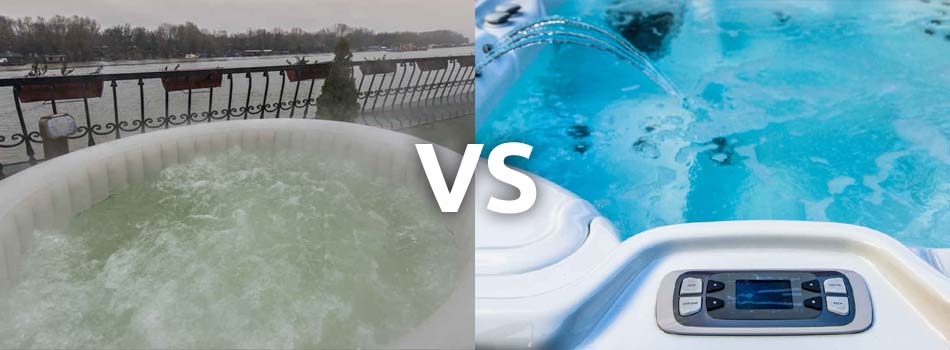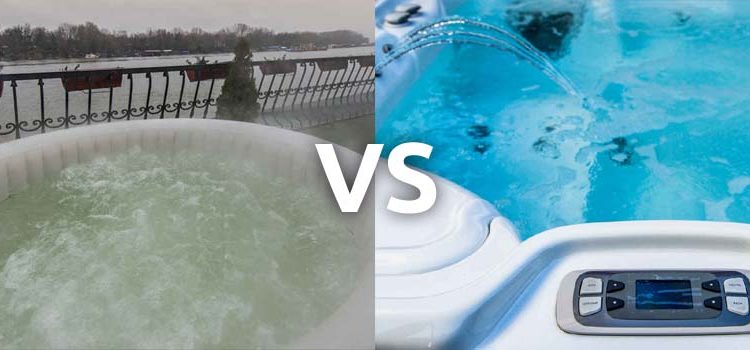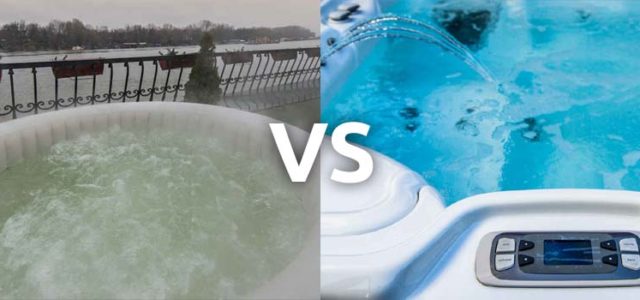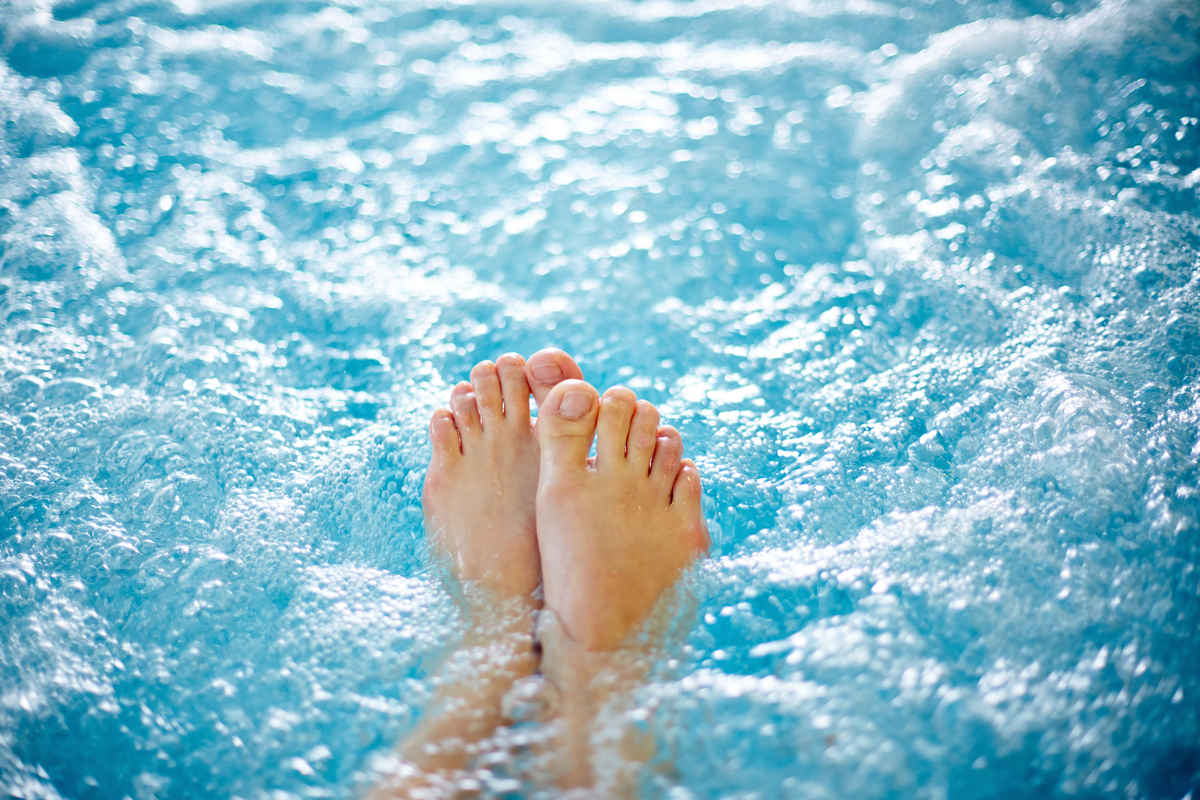


Inflatable hot tubs have taken the UK by storm in the last decade. Brands such as Bestway (who produce the ever-popular Lay Z Spa range) and Intex have released a huge number of inflatable hot tubs on to the market.
In fact, you can buy an inflatable hot tub to suit almost every budget and with a huge range of features. So, its no wonder they are giving regular hot tubs a run for their money.
In this guide, we’ll compare inflatable to regular hot tubs by weighing up the most important features that need to be considered before buying either one.
1 Price
Price is undoubtedly the main allure of inflatable hot tubs. With regular hot tubs costing in excess of £4000, they offer a very affordable alternative.
Budget models can be bought for as little as £300 and even the premium models max out at around £1200. In general, inflatable hot tubs will always best regular hot tubs on price. Allowing you to enjoy the bubbly, soothing experience of a hot tub without the steep price tag.
2 Installation And Setup

Regular hot tubs need some planning. Not only do you need to select a suitable, permanent location beforehand, but you’ll also need to arrange running power to it. This can incur additional expense and the further you’d like your hot tub from your home the more it will cost.
Inflatable hot tubs are a lot more forgiving in their setup. No tools or expertise are required. In fact, many can be setup in as little as 20-30 minutes. You can even deflate your hot tub and move it to another location if you don’t like its initial placement. Many also arrive with suitably long power cables which give you some flexibility where you place them in relation to your home.
3 Maintenance
When it comes to regular maintenance inflatable and regular hot tubs have similar requirements. Both require the water filter cleaning on a regular basis. In addition, both also require the chemical treatment of the water needs to keep the pH level stable and to prevent harmful bacteria from growing.
4 Heat Up Time

Before using your hot tub for the first time it needs to heat the water. For both inflatable and hard plastic tubs this can take anywhere from 12-24 hours on average.
The warmer the ambient temperature the less time the water takes to heat. For example, on hot summer days, a hot tub can heat in as little as 6-8 hours. Whereas during the colder times of the year it can take a full 24 hours.
The only notable difference is the heating duration. As a rule of thumb, inflatable hot tubs are not designed to heat the water continuously for weeks or months at a time. Instead, they often feature a timer function that can be set to switch on the heating system at set times.
The downside is that using your hot tub requires a little planning and you can’t just hop in at a whim. The upside is that the running costs of inflatables are considerably lower than regular hot tubs. It also helps increase the longevity of the hot tub because the pump isn’t being used continuously.
5 Features

At a bare minimum there are certain features we expect from any hot tub. The first is heated water and the second are bubbles and water-jets that transform the water into a Jacuzzi style experience.
Every inflatable hot tub heats the water. However, not every hot tub features a water-jet system. For example, Lay Z Spa’s budget hot tubs, such as the Miami, only feature an air jet system. This forces air at pressure through small openings in the base of the hot tub to create streams of soothing bubbles.
In contrast, Lay Z Spa’s premium models feature both systems. If you opt for one of their hydro-jet models, such as the Palm Springs HydroJet, you’ll also get water jet nozzles. These push the water around the tub to create a swirling sensation in addition to the bubbles created by the airjets.
6 Durability
The build of inflatable hot tubs is surprisingly excellent. The growth in this market has fueled a series of innovative construction methods and material improvements that have increased their resistance to general wear and tear.
The most notable of which is TriTech technology and i-beam construction. Tritech technology combines 3 different layers of laminated plastic which provide excellent resistance to punctures and wear.
Whereas i-beam construction makes the sides of the hot tub incredibly sturdy and able to take the weight of people climbing in and out without collapsing or bending.
In general, you’ll find that modern inflatable hot tubs are as durable as hard plastic shells if cared for and not abused.
7 Accessories

Floating bars and lights, protective canopies, inflatable headrests, hot tub surrounds and waterproof Bluetooth speakers. Nearly every kind of gizmo and gadget is available for the inflatable hot tub.
So whilst some of these features come built-in to regular hot tubs as standard, it does not mean they are not available for the inflatable hot tubs as additional extras. The plus point here is that you get to pick and choose what you would like if any, and this also factors into inflatable hot tubs lower price point.
Inflatable Hot Tubs Vs Regular – Which Is Best?
Ultimately neither hot tub type is better than the other. They both have their pros and cons and both are similar in terms of performance, features and functionality.
It really isn’t a question of which one is better, but rather, which one is right for you. With this in mind, we would recommend considering three key points. The first of which is the price, the second is flexibility and the third is usage.
Price is an obvious consideration. But flexibility and use are equally as important in determining the most suitable kind of hot tub.
Regular hot tubs are permanent fixtures and will eat up a portion of your garden. Inflatable hot tubs can be moved or packed away as required. This gives you the flexibility to move it as needed or free up extra space in your garden when needed.
Usage is equally as important. If you plan on using your hot tub a lot EG every day or two then a regular hot tub would be a better choice since it will be ready to use anytime.
However, if you don’t plan on using your hot tub too often then a better choice would be an inflatable. This would provide a saving not just on the initial outlay but also the running costs. Since it can be expensive to heat a hot tub, why heat one 24/7 when it is only used every week or two?
Inflatable hot tubs might not yet be as sophisticated all-round as regular hot tubs but there are certainly catching up. When you combine this will their much lower price point and lower running costs, they provide a viable alternative to anyone looking for the hot-tub experience without the exorbitant price tag. They also cater to those who would like the flexibility to claim back precious space in their garden when the hot tub is not in use – a nice perk which hard plastic hot tubs cannot provide.





